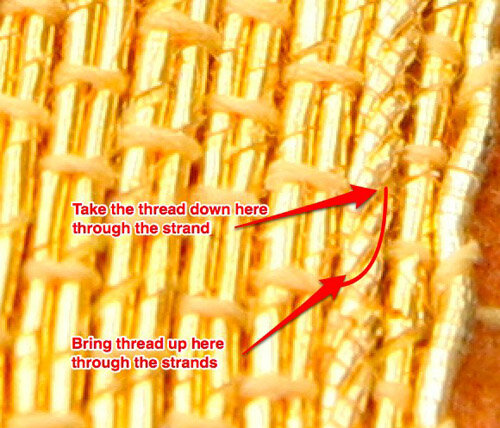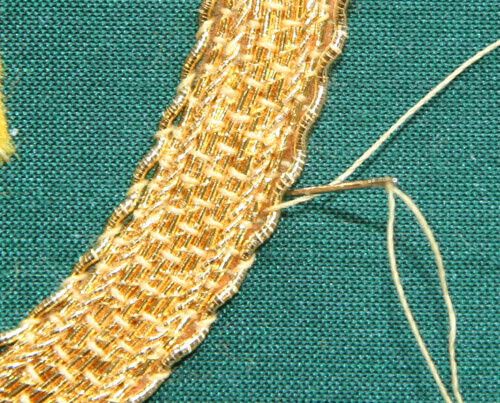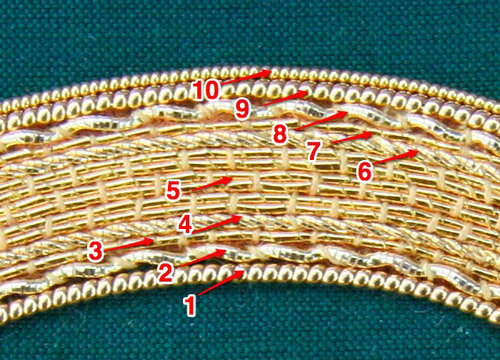RSN Goldwork Day 3: Twist and Rococo
After the center section of the crook or crosier (Bishop's staff) was all laid using Japanese thread, I had to couch down some different threads. A requirement of the gold work course for the RSN Certificate is to include in the design an area of mixed thread laid work. The Japanese thread was only one of the 6 different threads I would eventually couch down to complete the crook. I would use Japanese, twist, rococo, Pearl purl #2 and super fine Pearl purl.On different threads I used different techniques to couch them onto the fabric. Japanese threads call for straight stitches stitched perpendicularly over 1 or 2 threads.Twist thread, which is made of three fine strands all twisted together, calls for securing the gold thread to the fabric by bringing the needle up through the center of the thread - between the three individual threads and back down about 0.5 cm away. Angle your thread in the direction of the twist so the stitch sinks down between the strands. In this way the couching thread is hidden because it sinks into the twist. Rococo is couched by coming up from the inside over the thread, angling the thread slightly and tucking it in from the outside under the curve. This hides the thread slightly. Because the thread is wavy there will be gaps between rococo thread and a flat thread like Japanese or twist.
Rococo is couched by coming up from the inside over the thread, angling the thread slightly and tucking it in from the outside under the curve. This hides the thread slightly. Because the thread is wavy there will be gaps between rococo thread and a flat thread like Japanese or twist. The threads that make up the crosier (Bishop's staff) are all attached by couching them down to the fabric. The crosier is an area of mixed laid work. (I will talk later about couching the pearl purl.) The threads are laid in a pattern that is symmetrical from the inside to the outside edge except for the final outside line of super fine Pearl purl.
The threads that make up the crosier (Bishop's staff) are all attached by couching them down to the fabric. The crosier is an area of mixed laid work. (I will talk later about couching the pearl purl.) The threads are laid in a pattern that is symmetrical from the inside to the outside edge except for the final outside line of super fine Pearl purl. Here is a list of the threads you see in the photo above with a very brief explanation of how to couch them onto your backing fabric.1. Pearl purl #2 - I will talk about attaching this later2. Large rococo - come up on the inside, making your stitch diagonal, going down on the inside3. Single Japanese trend couched with straight perpendicular stitches4. Twist couched by bring the thread up, through the split in the thread, angling the thread in the direction of the twist and taking it back down5. Double Japanese thread, couched down two at a time in a brick pattern.6. Twist again7. Single Japanese thread again8. Large rococo again9. #2 Pearl purl10. #1 Fine Pearl purlWhat I found interesting is that Japanese thread - which is the smoothest thread I used and the one where the stitching would show the most - has a pattern to the couching. The couching pattern becomes part of the texture of the thread. With the twist and the rococo the couching thread is hidden a bit more because the thread itself is more textured.Although I did a LOT of couching on this piece, I really enjoyed it, partly because I used different threads and therefore different techniques. But mostly I liked it because it looked so beautiful when I was finished! Although it's not yet perfect, I can imagine the day when I will do things far better and with even greater skill and I'm inspired to continue improving my couching skills!
Here is a list of the threads you see in the photo above with a very brief explanation of how to couch them onto your backing fabric.1. Pearl purl #2 - I will talk about attaching this later2. Large rococo - come up on the inside, making your stitch diagonal, going down on the inside3. Single Japanese trend couched with straight perpendicular stitches4. Twist couched by bring the thread up, through the split in the thread, angling the thread in the direction of the twist and taking it back down5. Double Japanese thread, couched down two at a time in a brick pattern.6. Twist again7. Single Japanese thread again8. Large rococo again9. #2 Pearl purl10. #1 Fine Pearl purlWhat I found interesting is that Japanese thread - which is the smoothest thread I used and the one where the stitching would show the most - has a pattern to the couching. The couching pattern becomes part of the texture of the thread. With the twist and the rococo the couching thread is hidden a bit more because the thread itself is more textured.Although I did a LOT of couching on this piece, I really enjoyed it, partly because I used different threads and therefore different techniques. But mostly I liked it because it looked so beautiful when I was finished! Although it's not yet perfect, I can imagine the day when I will do things far better and with even greater skill and I'm inspired to continue improving my couching skills!
